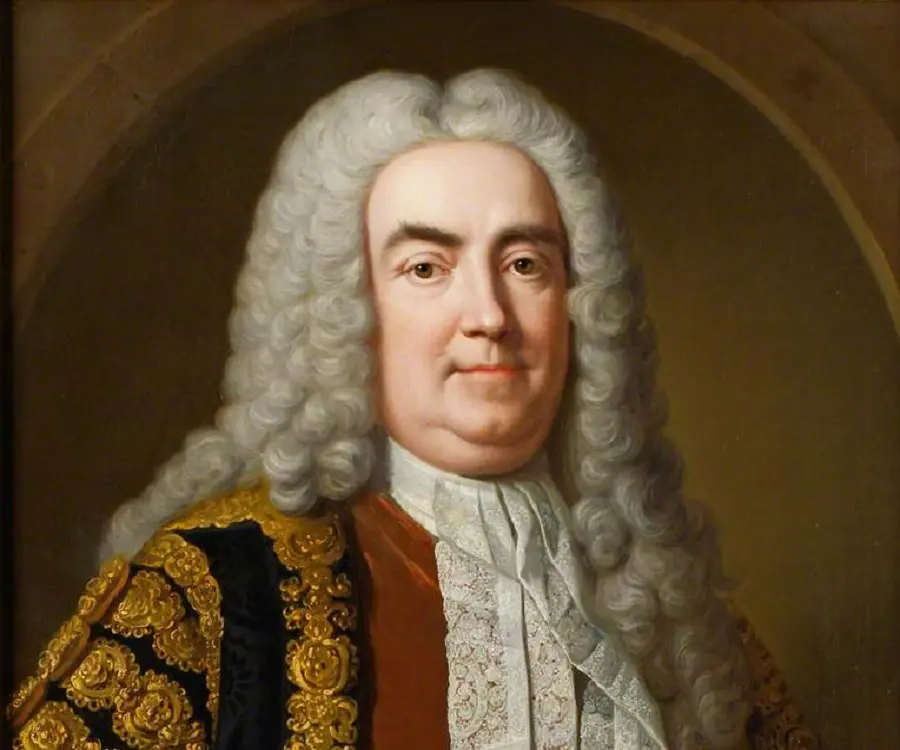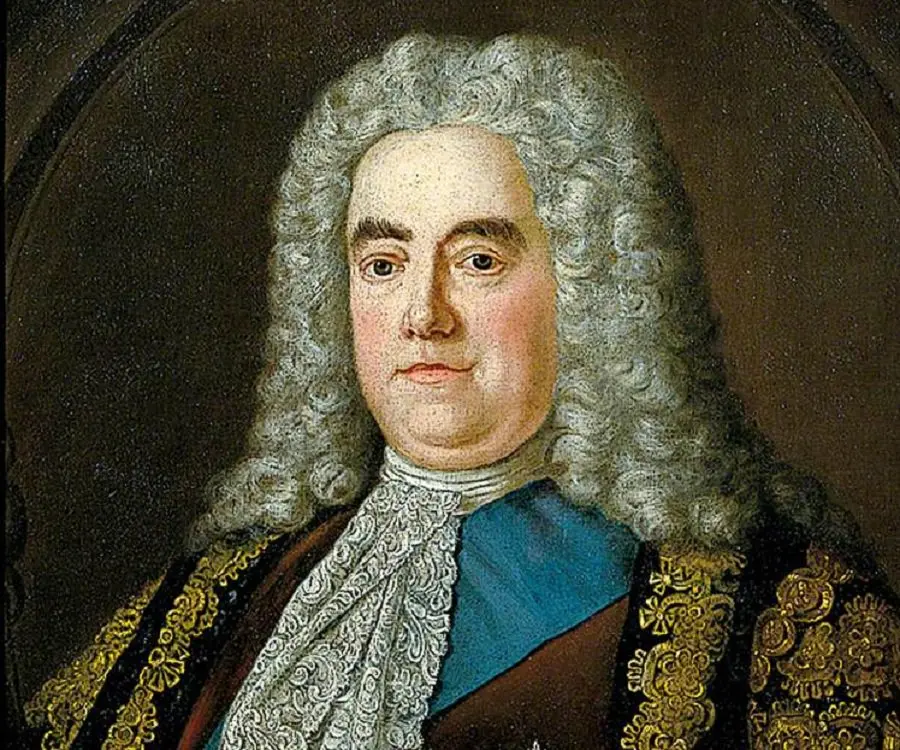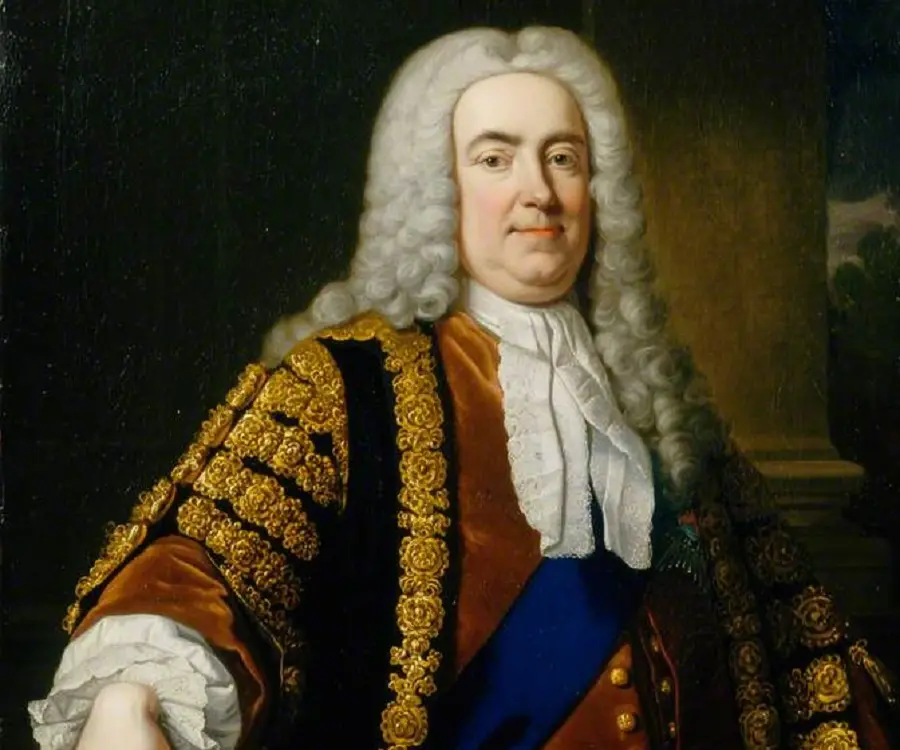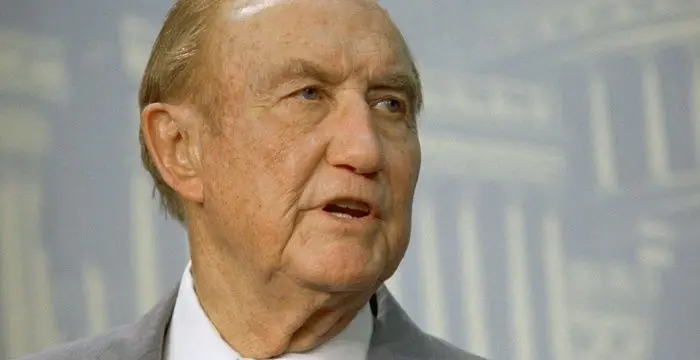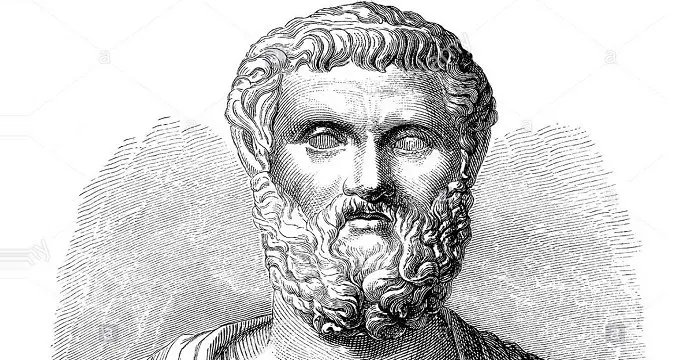
Robert Walpole - First Prime Minister of Great Britain, Facts and Facts
Robert Walpole's Personal Details
Sir Robert Wapole was the first Prime Minister of Great Britain from 1721 to 1742
| Information | Detail |
|---|---|
| Birthday | August 26, 1676 |
| Died on | March 18, 1745 |
| Nationality | British |
| Famous | Eton College, Leaders, Political Leaders, Prime Ministers, First Prime Minister of Great Britain |
| Spouses | Catherine, Lady Walpole, Maria |
| Siblings | 1st Baron Walpole, Dorothy Walpole, Horatio Walpole |
| Known as | Sir Robert Walpole |
| Childrens | Robert Walpole |
| Universities |
|
| Notable Alumnis |
|
| Birth Place | Houghton, Norfolk |
| Political Ideology | Political party - Whig |
| Gender | Male |
| Sun Sign | Virgo |
| Born in | Houghton, Norfolk |
| Famous as | First Prime Minister of Great Britain |
| Died at Age | 68 |
Robert Walpole's photo
Who is Robert Walpole?
Sir Robert Walpole was a British statesman who served as the first Prime Minister of Great Britain. His tenure lasted for twenty years making him the longest serving Prime Minister in British history, a record which he holds till date. Coming from a politically active family, Walpole’s influence was such that his era of dominance is fondly remembered as Robinocracy or Robinarchy. A Whig politician, he first came into politics in 1701 as a member of the parliament. Soon, he jumped up the ladder and took up many senior positions. It was under George I’s reign that Walpole was first elected as the Prime Minister of Great Britain in 1721, a chair that he held until 1742. Under his premiership, Britain prospered and shined. He helped establish peace by signing peace treatises, bettered Britain financial situation by lowering taxes, prevented major financial crux by reinstating government funds after South Sea Bubble collapse, pioneered protectionist policies thus enabling import and export and treaded the mid path by allowing tolerance for Protestant Dissenters. What gave him the edge over other politicians of his day was his middle route. He avoided high-intensity disputes in a jiffy by simply taking the mid path thus attracting moderates from both the Whig and the Tories. All through his life, Walpole excelled at establishing an effective working relationship between the Crown and the Parliament which stood as a major example for future prime ministers to follow
// Famous Prime Ministers
Edi Rama
Edi Rama is the current Prime Minister of Albania. Check out this biography to know about his childhood, life, achievements, works & timeline.
Leo Varadkar
Cam Leo Varadkar is the current Taoiseach—the Prime Minister—of the Republic of Ireland. Check out this biography to know about his childhood, family life, achievements and other facts about his life.
Fatos Nano
Fatos Nano is an Albanian politician who served as Prime Minister of Albania for several times. Check out this biography to know about his childhood, life, achievements, works & timeline.
Childhood & Early Life
Robert Walpole was born on August 26, 1676, in Houghton, Norfolk, to Robert and Mary Walpole. He was one of the nineteen children born to the couple. His father was a Whig politician and member of the aristocracy.
Robert Walpole secured his preliminary education from a private school in Massingham. Academically brilliant, he enrolled at Eton College in 1690. Later on, he secured admission at King’s College Cambridge and matriculated from the same on April 2, 1696.
Walpole originally planned to become a clergyman. However, following the death of his two elder brothers, he became the eldest heir to his family estate. He gave up on the idea of becoming a clergyman and instead helped his father in managing the family estate.
Career
Following the death of his father in 1700, Walpole succeeded to the family estate. In 1701, he began his political career and became a member of the parliament for Castle Rising. In 1702, he left Castle Rising to represent King’s Lynn.
Walpole’s political career was marked by rapid progress. He became a member of the Admiralty board and by 1708, was appointed as the Secretary of War. Briefly, he served as the Treasurer of the Navy from 1710 to 1711.
The rise of the Tories in the 1710 general election put a halt to Walpole’s political career. He remained a loyal Whig politician and soon became the most outspoken member of the opposition. In 1712, Walpole faced corruption charges and was imprisoned for six months.
In 1713, he was re-elected as MP for King’s Lynn. The death of Queen Anne and the subsequent succession of George I in 1714 marked the end of Tories rule as well. Tories opposed George I’s accession which led the Whig government to come to power.
Under the Whig government, Walpole was appointed as the Privy Councillor and Paymaster of the Forces. In 1715, he was made chairman of a secret committee formed to investigate the actions of the previous Tory ministry.
In 1715, he ascended late Lord Halifax as the First Lord of the Treasury and Chancellor of the Exchequer. In this position, Walpole introduced his sinking fund policy that would ensure reduced national debts. During his reign as the Treasurer and Chancellor, the cabinet was often divided between Lord Townshend and Walpole against Lord Sunderland and Stanhope on most issues. With King George I favouring Sunderland-Stanhope Ministry, Walpole and Lord Townshend remained nothing but sidekicks.
Walpole resigned from the cabinet and instead joined the opposition. He was favoured by the Prince of Wales, who was at opposition with the King. He soon became an advisor for Princess of Wales.
Walpole resumed his political career in 1720, after reconciling the differences between the King and Prince of Wales. He became a dominant figure in the House of Commons and was extremely influential. Walpole’s influence led to the abandonment of the Peerage Bill.
In 1720, Walpole returned to serve the position of Paymaster of the Forces. However, this acceptance of position made Walpole lose the favour of the Prince of Wales.
At the time when Walpole returned to the cabinet, Britain was engrossed in the South Sea Bubble hullabaloo. Against the popular belief, the company soon collapsed, causing major financial losses. Members of the cabinet including Stanhope and Sunderland were held responsible for the same. Walpole saved both of them from punishment and thus gained the nickname ‘The Screen’ and ‘Screenmaster-General’.
The death of Stanhope and resignation of Sunderland in 1721 made Walpole the most influential figure in the Cabinet. Same year, he was appointed First Lord of the Treasury, Chancellor of the Exchequer and Leader of the House of Commons. His appointment coincided with his term as the Prime Minister.
Under the premiership of Walpole, the government tried to overcome the financial crises following South Sea Bubble collapse. He steered the government towards financial prosperity with his compensation schemes that helped alleviate the sufferers.
On the political front, Walpole’s foresightedness not just helped prevent Jacobite rebellion under Francis Atterbury, but also prohibited the Tories from raising any rebellion. He even piloted signing of the peace treaty with France and Prussia. Walpole’s dominance prevailed as he consolidated Whig power.
Following the death of King George I, Walpole’s premiership came under threat. However, on Queen Caroline’s advice, wife of King George II, Walpole retained his position. His dominance grew largely. He created the Anglo-Austrian alliance through the Treaty of Vienna.
Walpole’s supremacy and power irked people both in opposition as well as those within the party. His policies were ceaselessly condemned by the periodical, ‘Craftsman’. However, Walpole was hardly bothered by it.
He continued with his effort to secure a bright and prosperous future for Britain. For the same, he imposed low taxes on people and introduced a policy that avoided war. He even influenced King George II from entering into the European conflict.
Walpole’s introduction of excise tax on wine and tobacco on stocks at warehouse irked the merchant class and led to a major opposition. The new proposal, though originally planned to restore the depleting national revenue caused by smuggling, created uproar. Adding fuel to fire was the increase in tax on gin. Though Walpole’s popularity weakened, his majority at the House remained constant.
Walpole earned the wrath of the literary figures when he persuaded the Parliament to pass the Licensing Act of 1737 under which London theatres were regulated. However, he rose above all.
Year 1737 marked the death of Queen Caroline. Though King George II shared a strong bond with Walpole by then, Walpole sole supremacy in the government was hampered strongly as Prince of Wales grew unreceptive of Walpole’s governance. The Prince of Wales formed a faction, Patriot Boys that opposed Walpole’s governance.
A military conflict marked the downward fall of Walpole. Dispute occurred between Spain and Great Britain over trade with West Indies. This led to the declaration of the 1739 War of the Jenkins’ Ear. Though Walpole opposed the war, the King, MPs and his own cabinet supported the same. His influence further suffered following the poor results of the 1741 general election that made his position unstable. He resigned from the government in 1742.
Following his resignation, Walpole remained active politically. He assisted the Ministry in the Lords, counselled the government on dealing with the patronage and even spoke on Minister’s behalf in the Lords. He acted as the ‘Minister behind the Curtain’, advising and influencing King George II.
Major Works
Walpole’s most remarkable contribution came as the Prime Minister of Great Britain from 1721 to 1742. He was the first and till date the longest serving Prime Minister of the country. His two decades long tenure witnessed Britai’sn rise and shine. He helped the country sail through the troubled financial phase following South Sea Bubble collapse. He lowered tax, increased exports, established peace and helped maintain an effective relationship between the Crown and the Parliament.
Awards & Achievements
On February 6, 1742, he was made 1st Earl of Orford by King George II.
Personal Life & Legacy
Walpole married Catherine on July 30, 1700. The couple was blessed with two daughters and three sons. Catherine died on August 20, 1737.
Before the death of his first wife, Walpole became romantically involved with Maria Skerrett. He married her by March 1738. The two had a daughter who following their marriage became his legitimate child.
By 1744, Walpole’s health rapidly deteriorated. He breathed his last on March 18, 1745. He was buried in the parish church of his home estate in Houghton, Norfolk.
Following his death, several streets, roads, towns have been named after him. He also has an island named after him on the border between Ontario and Michigan.
The nursery rhyme, ‘Who killed Cock Robin’ is mostly attributed to the fall of Walpole as he was popularly known by the nickname Cock Robin.
His house at 10 Downing Street was a gift from King George II. However, instead of using it as a personal gift, Walpole turned it into an official residence. The house has, since then, become the official residence of the Prime Minister of Britain.
// Famous Leaders
Edi Rama
Edi Rama is the current Prime Minister of Albania. Check out this biography to know about his childhood, life, achievements, works & timeline.
Tecumseh
Tecumseh was a Native American leader of the Shawnee clan. This biography profiles his childhood, life and timeline.
Khalifa bin Zayed Al Nahyan
Sheikh Khalifa bin Zayed Al Nahyan is the current President of the United Arab Emirates (UAE). Check out this biography to know about his birthday, childhood, family life, achievements and fun facts about him.
Robert Walpole biography timelines
- // 26th Aug 1676Robert Walpole was born on August 26, 1676, in Houghton, Norfolk, to Robert and Mary Walpole. He was one of the nineteen children born to the couple. His father was a Whig politician and member of the aristocracy.
- // 1690 To 2nd Apr 1696Robert Walpole secured his preliminary education from a private school in Massingham. Academically brilliant, he enrolled at Eton College in 1690. Later on, he secured admission at King’s College Cambridge and matriculated from the same on April 2, 1696.
- // 1700Following the death of his father in 1700, Walpole succeeded to the family estate. In 1701, he began his political career and became a member of the parliament for Castle Rising. In 1702, he left Castle Rising to represent King’s Lynn.
- // 30th Jul 1700 To 20th Aug 1737Walpole married Catherine on July 30, 1700. The couple was blessed with two daughters and three sons. Catherine died on August 20, 1737.
- // 1708Walpole’s political career was marked by rapid progress. He became a member of the Admiralty board and by 1708, was appointed as the Secretary of War. Briefly, he served as the Treasurer of the Navy from 1710 to 1711.
- // 1710 To 1712The rise of the Tories in the 1710 general election put a halt to Walpole’s political career. He remained a loyal Whig politician and soon became the most outspoken member of the opposition. In 1712, Walpole faced corruption charges and was imprisoned for six months.
- // 1713 To 1714In 1713, he was re-elected as MP for King’s Lynn. The death of Queen Anne and the subsequent succession of George I in 1714 marked the end of Tories rule as well. Tories opposed George I’s accession which led the Whig government to come to power.
- // 1715Under the Whig government, Walpole was appointed as the Privy Councillor and Paymaster of the Forces. In 1715, he was made chairman of a secret committee formed to investigate the actions of the previous Tory ministry.
- // 1715In 1715, he ascended late Lord Halifax as the First Lord of the Treasury and Chancellor of the Exchequer. In this position, Walpole introduced his sinking fund policy that would ensure reduced national debts. During his reign as the Treasurer and Chancellor, the cabinet was often divided between Lord Townshend and Walpole against Lord Sunderland and Stanhope on most issues. With King George I favouring Sunderland-Stanhope Ministry, Walpole and Lord Townshend remained nothing but sidekicks.
- // 1720Walpole resumed his political career in 1720, after reconciling the differences between the King and Prince of Wales. He became a dominant figure in the House of Commons and was extremely influential. Walpole’s influence led to the abandonment of the Peerage Bill.
- // 1720In 1720, Walpole returned to serve the position of Paymaster of the Forces. However, this acceptance of position made Walpole lose the favour of the Prince of Wales.
- // 1721The death of Stanhope and resignation of Sunderland in 1721 made Walpole the most influential figure in the Cabinet. Same year, he was appointed First Lord of the Treasury, Chancellor of the Exchequer and Leader of the House of Commons. His appointment coincided with his term as the Prime Minister.
- // 1721 To 1742Walpole’s most remarkable contribution came as the Prime Minister of Great Britain from 1721 to 1742. He was the first and till date the longest serving Prime Minister of the country. His two decades long tenure witnessed Britai’sn rise and shine. He helped the country sail through the troubled financial phase following South Sea Bubble collapse. He lowered tax, increased exports, established peace and helped maintain an effective relationship between the Crown and the Parliament.
- // 1737Walpole earned the wrath of the literary figures when he persuaded the Parliament to pass the Licensing Act of 1737 under which London theatres were regulated. However, he rose above all.
- // 1737Year 1737 marked the death of Queen Caroline. Though King George II shared a strong bond with Walpole by then, Walpole sole supremacy in the government was hampered strongly as Prince of Wales grew unreceptive of Walpole’s governance. The Prince of Wales formed a faction, Patriot Boys that opposed Walpole’s governance.
- // Mar 1738Before the death of his first wife, Walpole became romantically involved with Maria Skerrett. He married her by March 1738. The two had a daughter who following their marriage became his legitimate child.
- // 1739A military conflict marked the downward fall of Walpole. Dispute occurred between Spain and Great Britain over trade with West Indies. This led to the declaration of the 1739 War of the Jenkins’ Ear. Though Walpole opposed the war, the King, MPs and his own cabinet supported the same. His influence further suffered following the poor results of the 1741 general election that made his position unstable. He resigned from the government in 1742.
- // 6th Feb 1742On February 6, 1742, he was made 1st Earl of Orford by King George II.
- // 1744 To 18th Mar 1745By 1744, Walpole’s health rapidly deteriorated. He breathed his last on March 18, 1745. He was buried in the parish church of his home estate in Houghton, Norfolk.
// Famous Political Leaders
Edi Rama
Edi Rama is the current Prime Minister of Albania. Check out this biography to know about his childhood, life, achievements, works & timeline.
Khalifa bin Zayed Al Nahyan
Sheikh Khalifa bin Zayed Al Nahyan is the current President of the United Arab Emirates (UAE). Check out this biography to know about his birthday, childhood, family life, achievements and fun facts about him.
Leo Varadkar
Cam Leo Varadkar is the current Taoiseach—the Prime Minister—of the Republic of Ireland. Check out this biography to know about his childhood, family life, achievements and other facts about his life.
Strom Thurmond
Strom Thurmond was an American politician, who represented the state of South Carolina in the United States senate for 48 years.
Solon
Solon was an Athenian lawmaker, poet and politician. He is considered as one of the ‘Seven Wise Men’ in Greek culture. This biography provides detailed information about his childhood, life, career, works, achievements and timeline.
Mohammed bin Salman
Mohammed bin Salman is the Crown Prince of Saudi Arabia and the heir apparent to the throne. Check out this biography to know about his childhood, family life, achievements and other facts about him.
Robert Walpole's FAQ
What is Robert Walpole birthday?
Robert Walpole was born at 1676-08-26
When was Robert Walpole died?
Robert Walpole was died at 1745-03-18
Where was Robert Walpole died?
Robert Walpole was died in St James's
Which age was Robert Walpole died?
Robert Walpole was died at age 68
Where is Robert Walpole's birth place?
Robert Walpole was born in Houghton, Norfolk
What is Robert Walpole nationalities?
Robert Walpole's nationalities is British
Who is Robert Walpole spouses?
Robert Walpole's spouses is Catherine, Lady Walpole, Maria
Who is Robert Walpole siblings?
Robert Walpole's siblings is 1st Baron Walpole, Dorothy Walpole, Horatio Walpole
Who is Robert Walpole childrens?
Robert Walpole's childrens is Robert Walpole
What was Robert Walpole universities?
Robert Walpole studied at Eton College, King's College, Cambridge, Eton College
What was Robert Walpole notable alumnis?
Robert Walpole's notable alumnis is Eton College
What is Robert Walpole's political ideology?
Robert Walpole's political ideology is Political party - Whig
What is Robert Walpole's sun sign?
Robert Walpole is Virgo
How famous is Robert Walpole?
Robert Walpole is famouse as First Prime Minister of Great Britain
